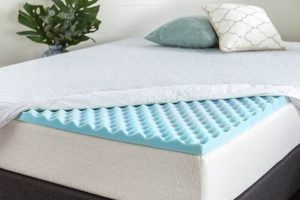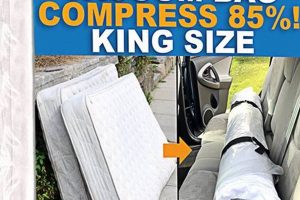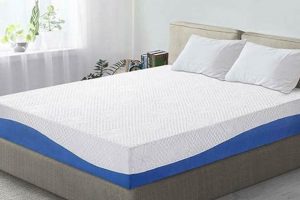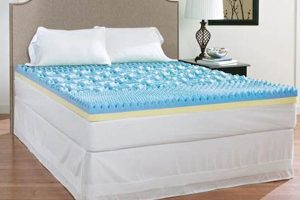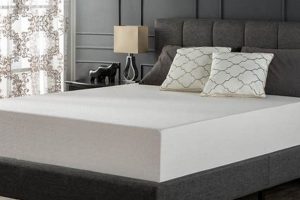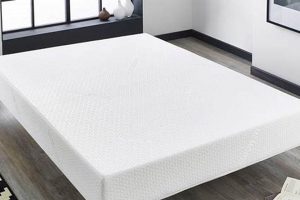These sleep surfaces integrate viscoelastic foam, known for conforming to the body’s shape, with gel particles or infusions. This combination seeks to alleviate pressure points and enhance thermal regulation during sleep. The conforming characteristic distributes weight evenly, potentially reducing discomfort and promoting spinal alignment. The presence of gel aims to dissipate heat, mitigating a common complaint associated with traditional viscoelastic materials.
The emergence of these products reflects a focus on optimizing sleep quality and addressing concerns about heat retention in bedding. The properties of pressure relief and temperature control are considered significant for individuals seeking improved sleep comfort. Historically, viscoelastic foam revolutionized bedding by offering customized support. The addition of gel represents a further evolution, targeting a specific limitation of the original material.
The subsequent sections will delve into the specific construction techniques employed in these products, the range of firmness options available, and considerations for selecting the appropriate model based on individual sleep preferences and health needs. Furthermore, the discussion will encompass the product’s durability, maintenance requirements, and comparative analysis against alternative bedding materials.
Guidance on Gel-Infused Viscoelastic Mattresses
The following guidelines offer practical advice for prospective purchasers and current owners, ensuring optimal utilization and longevity.
Tip 1: Assess Firmness Preferences: These mattresses are available in varying firmness levels. Consider individual sleep position and body weight when selecting a firmness. Side sleepers may benefit from a softer surface, while back and stomach sleepers may require firmer support.
Tip 2: Evaluate Density: Viscoelastic foam density impacts durability and support. Higher density foams generally offer greater longevity and resistance to impressions. Investigate the density specifications prior to purchase.
Tip 3: Inquire About Gel Distribution: The method of gel integration, whether infused or in bead form, can influence its cooling efficacy. Research the distribution technique to understand its potential for temperature regulation.
Tip 4: Investigate Airflow Design: Some models incorporate design features such as channels or open-cell structures to promote airflow. Enhanced airflow contributes to reducing heat retention and improving breathability.
Tip 5: Employ a Protective Mattress Cover: A waterproof and breathable cover shields against spills, stains, and dust mites, extending the lifespan of the mattress and safeguarding the warranty.
Tip 6: Rotate Regularly: Periodically rotating the mattress can help distribute wear and prevent indentations. Adhere to the manufacturer’s recommendations regarding rotation frequency.
Tip 7: Utilize a Supportive Foundation: Ensure the bed frame or foundation provides adequate support to prevent sagging and maintain structural integrity. A solid or closely slatted foundation is generally recommended.
Adhering to these guidelines can help individuals select and maintain a product that provides sustained comfort, support, and temperature regulation for restful sleep.
The subsequent section will provide information about where to buy them and the range of prices to expect.
1. Pressure Point Relief
Pressure point relief is a central benefit attributed to gel-infused viscoelastic mattresses. It directly influences sleep comfort and overall musculoskeletal health. The conforming nature of the foam, combined with the properties of gel, aims to reduce concentrated stress on specific areas of the body during sleep.
- Conforming Support and Weight Distribution
The viscoelastic component responds to body weight and temperature, molding to the individual’s unique contours. This characteristic distributes the body’s weight more evenly across the surface, minimizing pressure on bony prominences such as hips, shoulders, and knees. Effective weight distribution can alleviate discomfort and promote better circulation.
- Reduced Musculoskeletal Strain
By minimizing concentrated pressure, these mattresses can reduce strain on muscles and joints. This is particularly relevant for individuals with arthritis, fibromyalgia, or other conditions that cause pain and stiffness. Reduced strain contributes to a more relaxed and restorative sleep experience.
- Improved Spinal Alignment
The conforming support helps maintain proper spinal alignment during sleep. This is crucial for preventing or alleviating back pain. The mattress adapts to the natural curves of the spine, providing support where needed and preventing excessive sinking or arching.
- Enhanced Blood Circulation
Excessive pressure on certain areas of the body can impede blood flow. By reducing pressure points, these mattresses can promote better circulation, potentially reducing numbness, tingling, and discomfort. Improved circulation contributes to overall health and well-being.
The combined effect of conforming support, reduced musculoskeletal strain, improved spinal alignment, and enhanced blood circulation underscores the importance of pressure point relief in the context of gel-infused viscoelastic mattresses. The degree of pressure relief offered varies depending on factors such as foam density, gel distribution, and mattress firmness, highlighting the need for careful consideration when selecting a product.
2. Temperature Regulation
Temperature regulation is a significant factor influencing sleep quality and comfort, particularly concerning viscoelastic mattresses. Traditional viscoelastic materials are often criticized for heat retention. Gel-infused viscoelastic products attempt to mitigate this issue through various design and material modifications.
- Gel Infusion and Heat Dissipation
The integration of gel particles or layers within the viscoelastic matrix aims to improve thermal conductivity. Gel possesses a higher thermal mass than standard viscoelastic foam, enabling it to absorb and dissipate body heat away from the sleeper. The effectiveness of this depends on the concentration and distribution of the gel.
- Open-Cell Foam Structure and Airflow
Some manufacturers employ open-cell foam structures to enhance airflow within the mattress. Open cells create pathways for heat to escape and cool air to circulate, reducing heat buildup. The degree of airflow depends on the size and density of the cells within the foam.
- Phase Change Materials (PCM)
Certain products incorporate PCMs, whic
h absorb and release heat as they transition between solid and liquid states. PCMs can help maintain a consistent temperature throughout the night. The type and concentration of PCM influence the duration and effectiveness of temperature regulation. - Breathable Cover Materials
The mattress cover material plays a crucial role in airflow and moisture wicking. Breathable materials such as cotton or specialized synthetic fabrics facilitate the evaporation of sweat, preventing heat buildup. The cover’s construction and material composition influence its breathability.
The effectiveness of temperature regulation in gel-infused viscoelastic mattresses is contingent on a combination of factors, including gel concentration and distribution, foam structure, and cover material. Individuals sensitive to heat should carefully consider these factors when selecting a product, potentially opting for models with enhanced airflow or higher concentrations of gel or PCMs. Comparative analysis with traditional viscoelastic and other mattress types may also be beneficial.
3. Density and Support
Density and support are fundamentally intertwined characteristics dictating the performance and longevity of a gel-infused viscoelastic mattress. Density refers to the mass per unit volume of the foam, typically measured in pounds per cubic foot (lbs/ft). Support, in this context, denotes the mattress’s ability to maintain proper spinal alignment and prevent excessive sagging under body weight. High-density foam generally provides more robust support and greater resistance to compression over time.
- Impact of Density on Spinal Alignment
The foam’s density directly affects its capacity to conform to the body’s contours while simultaneously providing adequate support. Insufficient density may result in excessive sinking, leading to spinal misalignment and potential discomfort. Conversely, overly dense foam may lack sufficient conformity, creating pressure points. The optimal density range strikes a balance between these two extremes, promoting healthy spinal alignment for various sleep positions.
- Relationship Between Density and Durability
Higher-density foams exhibit greater resistance to compression and degradation over extended periods. A mattress composed of low-density foam is more susceptible to developing impressions or sagging, reducing its lifespan and compromising its support characteristics. Mattresses with higher densities tend to maintain their original shape and support level for a longer duration, representing a more durable investment.
- Influence of Density on Pressure Relief
While the gel infusion contributes to pressure relief, the underlying foam density plays a crucial role in distributing weight effectively. A high-density foam base provides a stable foundation for the conforming gel-infused layer, preventing bottoming out and ensuring consistent pressure relief across the entire sleep surface. Inadequate density diminishes the effectiveness of the gel infusion, concentrating pressure in specific areas.
- Cost Implications of Foam Density
Higher-density foams typically command a higher price point due to increased material costs and manufacturing complexity. However, the enhanced durability and extended lifespan associated with higher densities may represent a better long-term value proposition. Consumers should weigh the initial investment against the anticipated lifespan and performance benefits when selecting a gel-infused viscoelastic mattress based on density specifications.
The interplay between density and support underscores the importance of considering foam density as a critical selection criterion. The optimal density range for a gel-infused viscoelastic mattress is contingent on individual factors such as body weight, sleep position, and personal preferences. Careful evaluation of density specifications, in conjunction with other characteristics such as firmness and gel distribution, is essential for ensuring long-term comfort, support, and spinal health.
4. Conforming Ability
Conforming ability represents a core performance characteristic of gel-infused viscoelastic mattresses. It is the capacity of the mattress to adapt to the unique contours of the human body, providing personalized support and pressure relief. The degree to which a mattress conforms directly impacts sleep quality, spinal alignment, and overall comfort.
- Viscoelastic Response to Temperature and Pressure
Viscoelastic foam softens and yields under body heat and pressure, allowing the mattress to mold to the individual’s shape. This response distributes weight more evenly across the surface, minimizing pressure points on areas like the hips and shoulders. This feature can be especially beneficial for side sleepers and those with musculoskeletal conditions. The extent of the viscoelastic response determines the mattress’s ability to cradle the body and reduce pressure.
- Impact on Spinal Alignment and Posture
Effective conforming ability supports the natural curvature of the spine, maintaining proper alignment during sleep. By filling in the gaps between the body and the mattress, it prevents excessive sinking or arching, which can lead to back pain and discomfort. The mattress’s conforming action helps to promote a neutral spinal position, fostering a more restorative sleep experience. Different firmness levels within this type of mattress cater to various body types and sleep preferences, optimizing spinal alignment.
- Influence of Gel Infusion on Conformity
While the viscoelastic foam provides the primary conforming action, the presence of gel can influence this characteristic. Gel particles or layers may alter the foam’s responsiveness, potentially making it more pliable or providing a subtle cooling effect that enhances comfort. The gel’s integration can modify the surface feel of the mattress and impact the rate at which the foam conforms to the body’s shape. The distribution and density of the gel affect the extent of its influence on conformity.
- Long-Term Performance and Degradation
The conforming ability of a gel-infused viscoelastic mattress can change over time due to foam degradation and compression. Repeated use can lead to impressions or sagging, reducing the mattress’s ability to conform effectively. Factors such as foam density, manufacturing processes, and user weight influence the rate of degradation. Regular rotation and proper support can help extend the lifespan of the conforming ability.
The conforming ability of gel-infused viscoelastic mattresses is a dynamic characteristic, influenced by material properties, design features, and usage patterns. Its impact on comfort, spinal alignment, and pressure relief makes it a central consideration for consumers seeking a customized and supportive sleep surface. Understanding the factors that affect conforming ability allows for informed decision-making and optimized sleep health.
5. Motion Isolation
Motion isolation
, or the reduction of motion transfer across a sleep surface, constitutes a significant advantage associated with gel-infused viscoelastic mattresses. The material’s inherent properties dampen movement, minimizing the disturbance experienced by one sleeper when another shifts position or enters/exits the bed. This characteristic stems from the foam’s capacity to absorb energy rather than transmit it across the mattress. For instance, a couple where one partner is restless can benefit significantly from the motion isolation capabilities, potentially leading to improved sleep quality for both individuals.
The degree of motion isolation is influenced by several factors, including the foam’s density and thickness. Higher-density foams generally exhibit superior motion isolation due to their greater mass and energy absorption capacity. Furthermore, the presence of a gel layer can contribute to enhanced isolation by further dampening vibrations. An example of the practical significance can be observed in situations where individuals have differing sleep schedules; one person can move about without significantly disrupting the others rest. This function distinguishes these mattresses from traditional innerspring models, known for greater motion transfer.
In summary, the motion isolation properties of gel-infused viscoelastic mattresses offer a tangible benefit for individuals sharing a bed. The reduction in sleep disturbances promotes uninterrupted rest, contributing to improved overall sleep quality and well-being. While the effectiveness varies depending on specific product characteristics, motion isolation remains a compelling factor driving consumer interest in this mattress category.
6. Durability Expectations
The lifespan of a gel-infused viscoelastic mattress represents a critical consideration for prospective purchasers. Durability expectations encompass the anticipated period during which the mattress will maintain its support, comfort, and hygienic properties. Understanding factors influencing durability is essential for making informed purchasing decisions and managing long-term costs.
- Foam Density and Structural Integrity
The density of the viscoelastic foam core directly impacts the mattress’s resilience to compression and degradation. Higher-density foams exhibit greater resistance to sagging and indentation, contributing to a longer lifespan. Lower-density foams are more prone to losing their shape and support over time. For example, a mattress used nightly by a heavier individual will experience greater stress, potentially accelerating degradation of lower-density foams. The structural integrity of the foam base is thus a primary determinant of durability.
- Gel Infusion Method and Material Degradation
The method of gel integration, whether infused particles or layered construction, can influence durability. Over time, the gel may delaminate or break down, altering the mattress’s feel and potentially compromising its temperature-regulating properties. Consider, for instance, a gel-infused mattress subjected to frequent temperature fluctuations; the gel may be more susceptible to degradation, reducing its effectiveness. The long-term stability of the gel component is therefore a significant durability consideration.
- Support System and Foundation Compatibility
The type of foundation or support system used in conjunction with the mattress affects its longevity. Inadequate support can lead to uneven weight distribution, accelerating wear and tear. For example, placing a viscoelastic mattress on a slatted frame with excessive spacing between slats may result in sagging. Ensuring compatibility between the mattress and its foundation is crucial for maximizing its lifespan.
- Maintenance Practices and Environmental Factors
Proper maintenance, including regular rotation and the use of a protective mattress cover, can significantly extend the lifespan. Exposure to excessive moisture, sunlight, or extreme temperatures can also accelerate material degradation. For example, neglecting to protect the mattress from spills or allowing it to remain in a humid environment can promote mold growth and reduce its durability. Proactive maintenance and careful environmental control are essential for preserving mattress quality.
Ultimately, durability expectations for gel-infused viscoelastic mattresses are influenced by a complex interplay of material properties, construction techniques, support systems, maintenance practices, and environmental factors. Consumers should carefully consider these factors when evaluating different models and should adhere to recommended maintenance guidelines to maximize the lifespan of their investment.
7. Hypoallergenic Properties
The presence or absence of hypoallergenic properties in gel-infused viscoelastic mattresses is a relevant consideration for individuals susceptible to allergies or sensitivities. These mattresses, by virtue of their material composition and construction, can potentially impact the presence of allergens within the sleep environment. Understanding the interplay between these mattresses and allergen exposure is crucial for informed consumer choice.
- Dust Mite Resistance
Viscoelastic foam, due to its dense structure, tends to be more resistant to dust mite infestation compared to traditional innerspring mattresses. Dust mites are a common allergen trigger, and their proliferation within bedding can exacerbate allergic symptoms. The foam’s density limits the mites’ ability to penetrate and colonize the mattress core. This characteristic offers a potential advantage for allergy sufferers seeking to minimize dust mite exposure.
- Material Composition and Allergenic Potential
The specific materials used in the manufacturing of gel-infused viscoelastic mattresses can influence their allergenic potential. Certain foams may contain volatile organic compounds (VOCs) that can trigger allergic reactions or sensitivities in some individuals. Similarly, the adhesives and fabrics used in the mattress cover can also introduce potential allergens. Scrutinizing the material composition and certifications, such as CertiPUR-US, is advisable to minimize exposure to potentially allergenic substances.
- Mold and Mildew Resistance
The closed-cell structure of some viscoelastic foams can inhibit the growth of mold and mildew, which are also common allergens. However, moisture accumulation within the mattress can still create a conducive environment for microbial growth. The presence of gel, depending on its composition, may further influence the mattress’s resistance to mold and mildew. Maintaining a dry and well-ventilated sleep environment is essential for preventing microbial growth, regardless of the mattress’s inherent resistance.
- Cleanability and Allergen Removal
The ability to effectively clean and remove allergens from the mattress is a crucial aspect of hypoallergenic maintenance. Mattress covers that are removable and washable facilitate the removal of accumulated dust mites, pollen, and other allergens. Regularly vacuuming the mattress surface can also help minimize allergen buildup. The ease with which a mattress can be cleaned contributes significantly to its overall hypoallergenic properties.
The hypoallergenic potential of gel-infused viscoelastic mattresses is not absolute but rather dependent on a combination of factors related to material composition, construction, and maintenance practices. While these mattresses may offer some inherent advantages in terms of dust mite resistance, careful consideration of material sensitivities and diligent cleaning protocols are essential for minimizing allergen exposure and creating a healthier sleep environment.
Frequently Asked Questions
The following addresses prevalent inquiries regarding the selection, utilization, and maintenance of gel-infused viscoelastic mattresses, providing factual responses to assist in informed decision-making.
Question 1: What distinguishes gel-infused viscoelastic foam from traditional viscoelastic foam?
Gel-infused viscoelastic foam incorporates gel particles or layers, intended to enhance thermal conductivity and dissipate heat. Traditional viscoelastic foam, lacking this infusion, may exhibit greater heat retention.
Question 2: Does mattress firmness correlate with support?
Firmness and support are related but distinct attributes. While a firmer mattress may provide greater support for some individuals, optimal support is achieved when the mattress conforms to the body’s contours while maintaining spinal alignment, irrespective of firmness level.
Question 3: How frequently should a gel-infused viscoelastic mattress be rotated or flipped?
Rotation frequency recommendations vary by manufacturer. However, rotating the mattress 180 degrees every three to six months can promote even wear and extend its lifespan. Flipping is generally not recommended for models with a designated top surface.
Question 4: What type of foundation is most suitable for these mattresses?
A solid or closely slatted foundation is recommended to provide adequate support and prevent sagging. Box springs are generally not advised, as they may not offer sufficient support and can compromise the mattress’s structural integrity.
Question 5: How should stains or spills be addressed on a gel-infused viscoelastic mattress?
Promptly blot the affected area with a clean, dry cloth. Avoid harsh chemicals or excessive moisture. A specialized mattress cleaner may be used sparingly, following the manufacturer’s instructions. The use of a waterproof mattress protector is strongly recommended.
Question 6: What is the typical lifespan of a gel-infused viscoelastic mattress?
Lifespan varies depending on factors such as foam density, usage patterns, and maintenance practices. However, a well-maintained, high-quality model can reasonably be expected to provide satisfactory performance for seven to ten years.
In summary, gel-infused viscoelastic mattresses offer potential benefits in terms of pressure relief and temperature regulation, but their performance is influenced by factors such as material quality, construction, and individual preferences. Careful consideration of these aspects is essential for informed decision-making.
The next section will delve into a comparison of gel-infused viscoelastic mattresses against alternative bedding materials, providing a comprehensive overview of their relative strengths and weaknesses.
Conclusion
The preceding discussion has explored the characteristics of the gel foam memory mattress, encompassing aspects of material composition, performance attributes, and maintenance considerations. The integration of gel infusion within viscoelastic foam aims to address inherent limitations of traditional memory foam, primarily concerning heat retention and pressure distribution. While offering potential benefits in these areas, the overall effectiveness is contingent upon factors such as foam density, gel concentration, and individual preferences. The selection process necessitates a thorough evaluation of these variables to align product features with specific needs.
The purchase of a gel foam memory mattress represents a significant investment in personal health and well-being. Responsible evaluation, incorporating the aforementioned factors, facilitates informed decision-making, contributing to optimized sleep quality and long-term satisfaction. Further research into evolving material technologies and comparative product analysis remains crucial in navigating the complexities of the bedding market and ensuring a purchase that meets individual requirements effectively.


